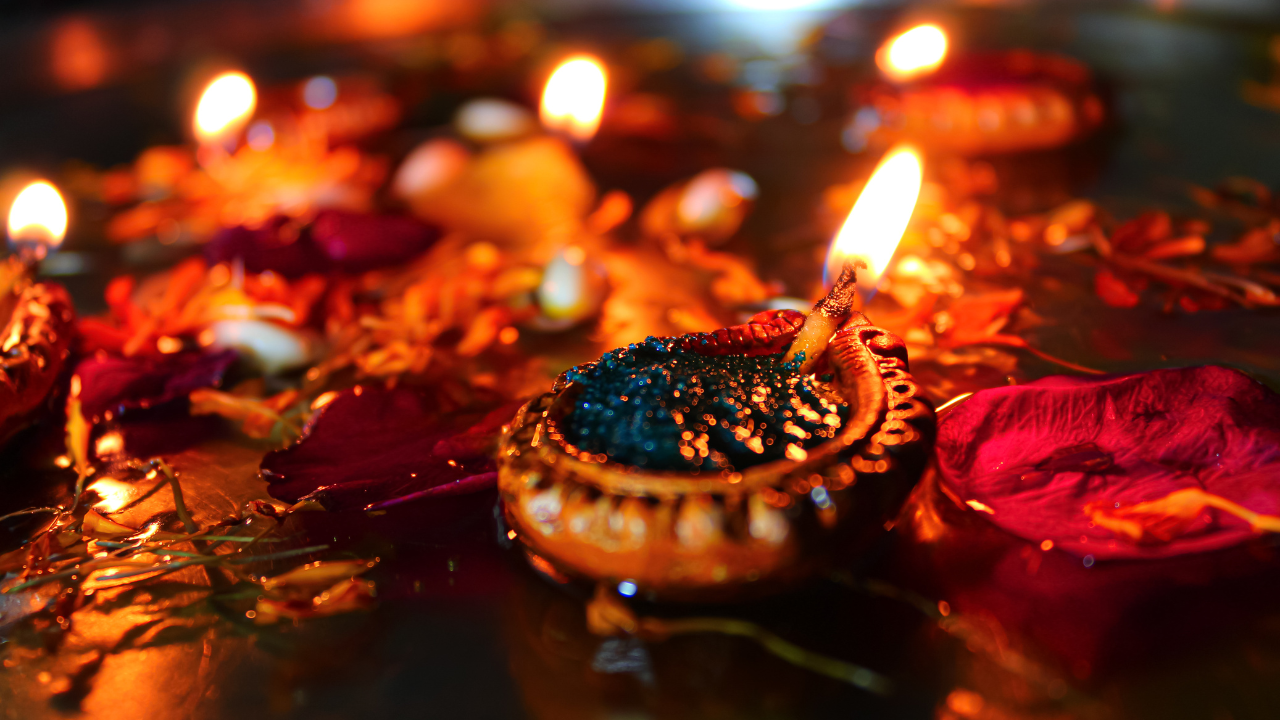
Unique Diwali traditions in different parts of India (Image credit: Canva)
Diwali, the festival of lights, is one of the most celebrated festivals in India and symbolizes the victory of good over evil and light over darkness. While the essence of Diwali remains the same, various regions of the country have their own unique customs and traditions to commemorate this grand occasion. Here are eight different Diwali traditions from different parts of India:
1. North India: Diwali and Ram Lila
In most parts of northern India, Diwali celebrates the return of Lord Rama to Ayodhya after 14 years of exile and his victory over Ravana. People light oil lamps, burst firecrackers and decorate their houses with Rangolis. The most unique tradition here is the staging of Ram Lila, a dramatic reenactment of the Ramayana. This takes place days before Diwali and ends with the symbolic burning of effigies of Ravana, Meghnath and Kumbhkaran. The celebration culminates with the worship of goddess Lakshmi on the night of Diwali in pursuit of wealth and prosperity.
2. West Bengal: Kali Puja
In West Bengal, Diwali coincides with Kali Puja, which is dedicated to goddess Kali, the destroyer of evil forces. While homes are decorated with diyas and lights, the focus is on worshiping Kali, the fierce form of the Divine Mother. Large statues of Kali are worshiped in pandals (temporary structures) and devotees offer flowers, sweets and animal sacrifices to the goddess. The night is spent in prayer, and the rituals continue until dawn, creating a mystical atmosphere that distinguishes it from Diwali in other regions.
3.Maharashtra: Vasu Baras and Govardhan Puja
In Maharashtra, Diwali celebrations begin with Vasu Baras, a festival where cows and calves are worshiped, recognizing their importance in agriculture and as symbols of prosperity. On Dhanteras, people buy gold or utensils as a sign of good luck. On Govardhan Puja or Padva, the day after Diwali, Maharashtrians prepare a lavish feast called Faral, which includes sweets like Ladoo, Chakli and Shankarpali. Brothers and sisters exchange gifts on Bhau Beej, similar to Raksha Bandhan.
4. Tamil Nadu: Thalai Deepavali
In Tamil Nadu, Thalai Deepavali has a special significance for newlyweds. It is the first Diwali celebrated by a couple after their marriage. The newlyweds visit the bride’s parental home, where they are showered with blessings and gifts. The morning begins with an oil bath, followed by prayers and wearing new clothes. Traditional sweets like Adirasam and Murukku are prepared. Additionally, houses are decorated with kolam (rangoli) patterns and families light lamps to invite prosperity.
5. Goa: Narkasur Vadh
Diwali celebrations in Goa are clearly marked by the tradition of Narkasur Vadh, which depicts the slaying of the demon Narkasur by Lord Krishna. The night before Diwali, large effigies of Narkasur parade through the streets, often accompanied by drums and music. These effigies are burned at dawn, symbolizing the triumph of good over evil. Later, houses are decorated with clay lamps and people exchange sweets and gifts.
6. Uttar Pradesh: Dev Deepawali in Varanasi
While Diwali is widely celebrated throughout Uttar Pradesh, the Dev Deepawali festival in Varanasi is especially notable. Celebrated on the full moon night of Kartik Purnima, 15 days after Diwali, the ghats of the Ganges are illuminated with thousands of oil lamps. This event is believed to be the day when the gods descend to Earth to bathe in the Ganges. The entire city is a light show, with devotees performing rituals and floating diyas on the river, making it a breathtaking experience.
7. Odisha: Kaunria Kathi and Badabadua Daka
In Odisha, people observe a unique ritual called Kaunria Kathi during Diwali. After Lakshmi Puja, families burn jute sticks in front of their houses to invite blessings from ancestors. This act is known as Badabadua Daka and people chant prayers seeking the protection of their ancestors. The chanting of the phrase “Badabadua ho…Andhara re aasa, Alua re jaa” (O ancestors, come in darkness and return in light) is an integral part of this tradition, which links the living with the souls of the deceased
8.Gujarat: Chopda Pujan and Sharda Pujan
In Gujarat, Diwali marks the end of the year in the traditional Hindu calendar and the celebrations are very business-oriented. On Dhanteras, merchants and businessmen perform Chopda Pujan, a ritual to worship their account books and start new financial records for the New Year. They seek the blessings of Goddess Lakshmi to ensure a prosperous financial year ahead. This is followed by Sharda Pujan, which involves worshiping books and tools related to education, business and wealth, which means a new beginning.
Disclaimer:
The information contained in this post is for general information purposes only. We make no representations or warranties of any kind, express or implied, about the completeness, accuracy, reliability, suitability or availability with respect to the website or the information, products, services, or related graphics contained on the post for any purpose.
We respect the intellectual property rights of content creators. If you are the owner of any material featured on our website and have concerns about its use, please contact us. We are committed to addressing any copyright issues promptly and will remove any material within 2 days of receiving a request from the rightful owner.
